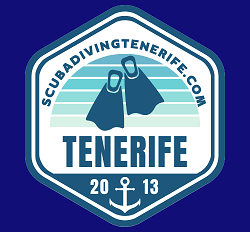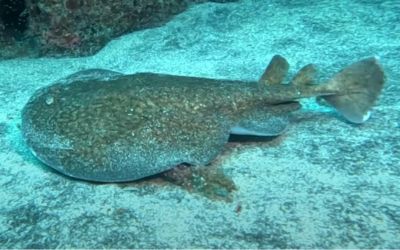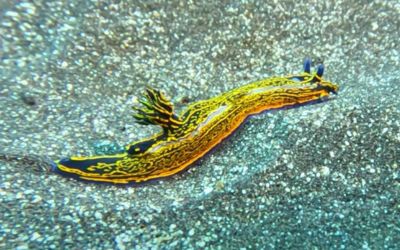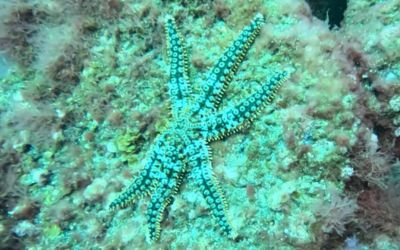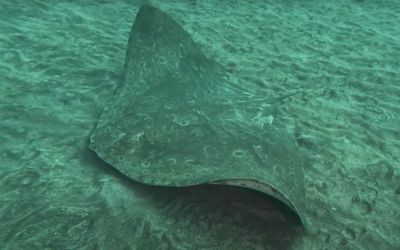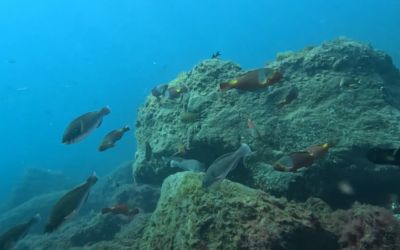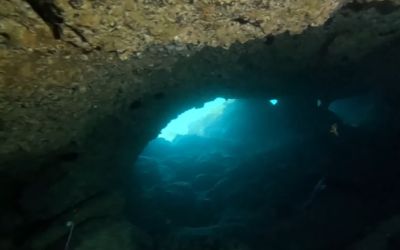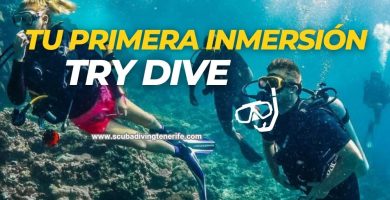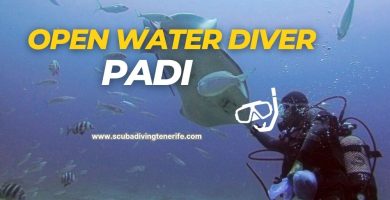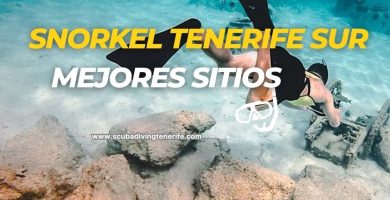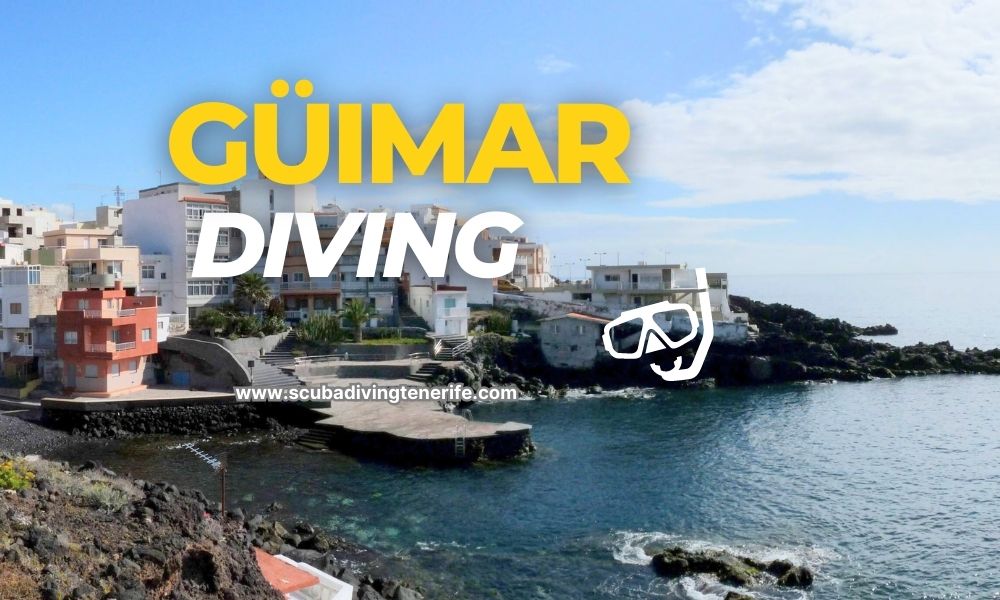
The coast of the municipality of Güimar has several dive spots for incredible dives. Below we show you the best dive sites in Güimar.
🧭 The best diving areas in Güimar
We tell you the most relevant information about the best dives in Güimar one by one:
🤿 El Tablado
El Tablado is a diving area located on the south coast of Tenerife. It is an ideal place for beginners and for night dives in summer. The average depth is 10 meters, but you can reach up to 15 meters.
- The bottom is rocky-sandy with small walls and caves, and there is a marine meadow in the middle of the bay. Access is very convenient from the shore, as there is a small jetty that also serves as a swimming area.
- In El Tablado, you can explore both sides of the coast, where you can find small caves a few meters deep. In addition, in the middle of the bay you can find a marine meadow very interesting for the observation of marine fauna.
- The ideal conditions for diving in El Tablado are 40% of the year, with light trade winds, southern weather and bonanza season.
- The current is non-existent, which makes the area very sheltered. The type of bottom is rocky-sandy and the small wall with caves is one of the most interesting areas in the area.
- In addition, in summer, it is recommended for companions. For photographers, it is recommended to bring a lens to take pictures of fish and invertebrates.
🤿 Los Barrancos
Los Barrancos is a little known but attractive diving area located on the south coast of Tenerife, near Santa Lucia. The average depth is 10 meters and the maximum depth is 17 meters, which makes it an ideal dive for divers of all levels, especially for those who are just starting out.
- The dive is scenic and offers a rocky bottom with whitish shallows.
- The area has several small caves to the left without separating from the shore. After 10 meters, the bottom becomes less rugged and ends in sand.
- Los Barrancos is a sheltered dive with no currents. It is only recommended to dive with good sea conditions, since the conditions are optimal only 20% of the year with light trade winds, south weather and good weather.
- Access to the area is from the shore, and has a small concrete staircase that facilitates access.
- The dive is very uncrowded and is only visited by local divers.
🤿 Playa Chica, La Caleta
Playa Chica, La Caleta is a diving area of Tenerife suitable for all levels, being ideal for those who are new to diving or for night dives. The area is known for its marine fauna, especially for the presence of frogfish and suckerfish.
- Access to the area is easy from the shore by the beach or by the stairs in the bathing area.
- To the left, without moving away from the shore, there are several ledges and caves to explore. In the bay there is a rocky area that can also be interesting.
- The ideal weather conditions for diving in this area are around 60% of the year, with light trade winds, southerly weather, and the bonanza season.
- The current is non-existent and the bottom type is mainly rocky, with small walls and ledges, and a scree in the bay.
- For photographers, it is recommended to bring a lens to take pictures of small and medium-sized wildlife.
🤿 El Espigón, La Caleta
The El Espigón de La Caleta dive site is a dive with an average depth of 20 meters and a maximum depth of 32 meters. It is a dive for medium level divers, who will enjoy the large amount of underwater life that inhabits the area.
- The most interesting area to dive in El Espigón is the reef that is located on the outskirts and to the left of the point.
- Here you can find caves and snorkelers that will surprise divers. The rocky and very rugged bottom of the area is also an interesting place to explore.
- The conditions for diving in El Espigón are optimal during 50% of the year, since the NE wind can affect the area.
- Current is frequent and can be moderate if present, and swell can also affect diving conditions.
- It is advisable to wear booties with soles to protect your feet and to be cautious in case of currents.
🐠 What marine species can be seen in the area?
- Sea horse mackerel: It is a very peculiar animal, with an elongated shape and a crown on its head that makes it look like a horse. It lives in areas of algae and posidonia and feeds on small crustaceans.
- Pejepipa: It is a small fish, with an elongated shape and laterally compressed body. It feeds on crustaceans, mollusks and worms.
- Gallinita: Fish with an elongated and slender body, brown or grayish in color. It feeds on small crustaceans and worms.
- Tamboril: A fish with a globular body, covered with spines and a large funnel-shaped mouth. It feeds on small fish and crustaceans.
- Gallito: Fish with an elongated and flattened body, with highly developed dorsal and anal fins. It feeds on crustaceans, mollusks and small fish.
- Chopa: Fish with an elongated and slender body, silver in color. It feeds on small crustaceans and mollusks.
- Rubio: Fish with an elongated and flattened body, silver in color. It feeds on crustaceans, mollusks and small fish.
- Choco: Cephalopod mollusk with an oval body, two tentacles longer than the rest and a horny beak with which it crushes its prey.
- Octopus: Cephalopod mollusk with a soft body and eight arms equipped with suction cups to hold on to rocks and capture prey.
- Nudibranchs: Marine mollusks with a soft body and no shell. They have a great variety of shapes and colors and feed on other invertebrates.
- Seagrass meadow: Underwater vegetation formed by species such as posidonia and algae. It serves as habitat for a great variety of marine species.
- Roncadors: Fish with an elongated and flattened body, a small head and a large mouth. They feed on small crustaceans and mollusks.
- Salmon: Fish with an elongated and slender body, pink or reddish in color. It feeds on crustaceans and small fish.
- Vieja: Fish with an elongated and flattened body, a large head and a small mouth. It feeds on algae and small invertebrates.
- Jurel: Fish with an elongated and slender body, with highly developed dorsal and anal fins. It feeds on crustaceans, mollusks and small fish.
- Anemones: Flower-shaped marine invertebrates with stinging tentacles used to capture prey.
- Shrimp: Small crustaceans, with an elongated and slender body and two pincers in the front.
- Red gorgonian: Species of fan-shaped soft coral, reddish in color. It serves as habitat for a great variety of marine species.
